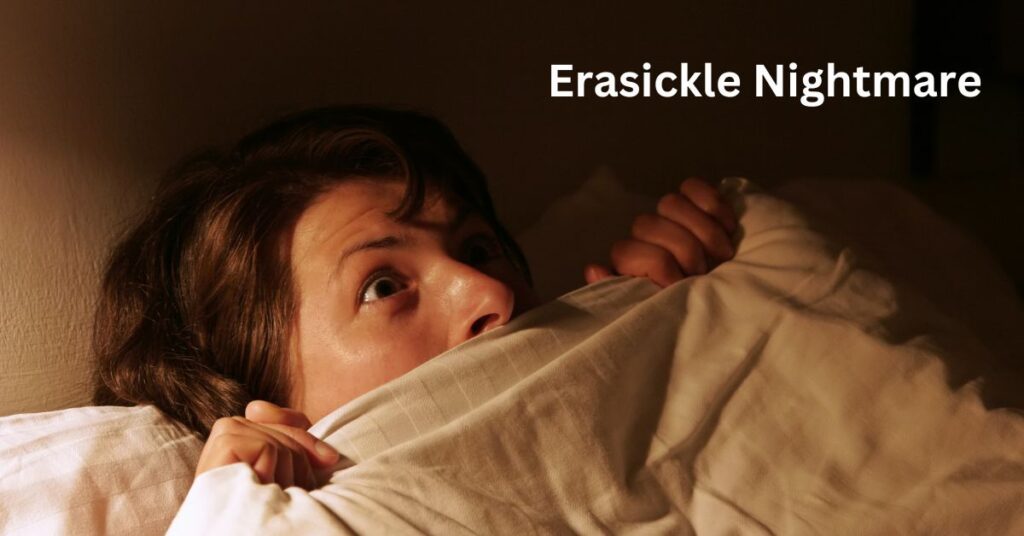
The Erasickle Nightmare stands out as a particularly eerie experience in the field of sleep disorders. This kind of sleep paralysis, which is characterized by vivid, horrific dreams that seem all too real, has captured people’s imaginations for centuries. The Erasickle Nightmare has had a lasting impact on modern literature, media, and mythology from antiquity. Come along as we explore the origins, scientific basis, and coping mechanisms of the eerie Erasickle Nightmare. Discover the mysterious realm of this phenomenon.
Contents
What exactly is the Erasickle Nightmare?
Regarding sleep disruptions, the imaginative bad dream sticks out as very unsettling. This kind of sleep paralysis, which is characterized by vivid, horrific dreams that seem all too real, has captured people’s imaginations for centuries. Across historical tradition, contemporary literature, and culture, the imaginative evil dream has made a lasting impression on our shared understanding.
The brief incapacity to move or talk during falling or waking up is known scientifically as sleep paralysis. People may have strong hallucinations during these periods that seem to be identical to reality. These nightmares frequently feature feelings of tension, fear, and sometimes panic, along with a sensation of being restrained or trapped. The Old English word “Erasickle,” which means “to be seized or paralyzed,” is the source of the name “Erasickle Nightmare.”
Even though imaginative unpleasant dreams are uncommon, they can cause great misery to the person with them. According to estimates, it affects 2% to 6% of the population overall, with certain people being more likely to experience it than others. Sleep paralysis episodes are known to be more common in situations involving stress, anxiety, lack of sleep, and specific medical disorders. To effectively manage and live with this unpleasant phenomenon, it is imperative to comprehend the nature and causes of it.
A History of the Erasickle Nightmare
Evidence of the Erasickle Nightmare dating back thousands of years indicates that it has been around for ages. It was thought to be brought on by the god Pan in ancient Greece, who was known to give dreadful dreams to anybody who interrupted his slumber. Similar phenomena was also believed in by the Romans, who called it the “incubus,” a demon that would sit on people’s chests and give them nightmares.
The Erasickle Nightmare was frequently connected to demonic possession and witchcraft during the Middle Ages. Individuals who had these dreams were sometimes even burnt at the stake since it was believed that they were working with the devil. As scientific knowledge of the human body and mind increased, the idea that an imaginative, unpleasant dream was a paranormal experience gave way to a medical one. Initially documented in medical journals in the 1800s, it was known as “sleep paralysis.”
It is now acknowledged that it is a widespread sleep ailment that can impact anyone. It is believed to be brought on by a transient disturbance in the brain’s sleep-wake cycle, which can result in extremely realistic and vivid dreams. Though an imaginative horrible dream can be terrifying, it’s important to realize that this is a harmless ailment that will soon disappear.
The Erasickle Nightmare in popular culture
Several popular culture mediums, such as comic comics, video games, film, television, and literature, have all included the Erasickle Nightmare. This section will examine how the imaginative bad dream has been portrayed in various media and how themes of fear, anxiety, and the paranormal have been explored through its utilization.
The has appeared in literary works by writers like Stephen King, H.P. Lovecraft, and Edgar Allan Poe. The imaginative terrible dream examines the darker aspect of human nature and frequently evokes a sense of tension and fear in these works. He has appeared in movies and TV shows like Stranger Things, The X-Files, and The Nightmare on Elm Street. These pieces frequently investigate the paranormal and evoke terror using the imaginative terrible dream. The creative nightmare has appeared in video games like Dark Souls, Resident Evil, and Silent Hill. These pieces frequently explore the perils of the unknown and evoke a sense of challenge through the use of the Erasickle Nightmare. The imaginative bad dream has appeared in comic novels like Spawn, Hellblazer, and The Sandman. The Erasickle Nightmare is frequently used in these pieces to examine themes of evil and salvation.
Popular culture has employed the Erasickle Nightmare to examine several themes, such as anxiety, dread, and the paranormal. These subjects are frequently discussed in an engaging and thought-provoking manner. The dark aspect of human nature has also been explored through the imaginative terrible dream, which likewise offers readers, viewers, and gamers a sense of catharsis.
The Science Behind the Erasickle Nightmare
The different ideas put forth to explain the origin of the Erasickle Nightmare will be examined in this section.
- According to one explanation, the Erasickle Nightmare is brought on by a brief disruption in the brain’s sleep-wake cycle. Dreams happen when the brain is in the REM sleep period, which this problem might partially awaken. This semi-awake state can produce vivid, disturbing, and remarkably realistic dreams.
- Another view holds that stress, worry, and lack of sleep are the causes of imaginative terrible dreams. These things can potentially throw off the sleep-wake cycle and increase the likelihood that the brain will wake up partially during REM sleep.
- Lastly, some experts think that a mix of environmental influences, personality traits, and heredity may be the source of the imaginative horrible dream. The precise etiology of the Erasickle Nightmare requires further investigation. Nonetheless, this section’s beliefs offer a foundation for comprehending this intriguing and occasionally terrifying sleep illness.
Coping with the Erasickle Nightmare
Although it can be difficult, people can use several techniques to control and lessen the frequency and intensity of these episodes. Creating a regular sleep pattern and practicing proper sleep hygiene is critical. To encourage greater sleep quality, this entails going to bed, waking up at the same time every day—even on weekends—and establishing a calming bedtime routine.
Deep breathing exercises, yoga, and meditation are examples of relaxation practices that might help lessen stress and anxiety, major causes of the Erasickle Nightmare. Avoiding alcohol and caffeine right before bed will also enhance the quality of your sleep and reduce the chance that you’ll have sleep problems.
For those who experience severe or regular Erasickle Nightmares, getting professional assistance from a therapist or counselor can also be helpful. Therapy can assist in determining the underlying causes of these episodes as well as in the development of coping skills and anxiety and stress management techniques.
Establishing a peaceful and comfortable sleeping space is crucial. This ensures the bedroom is quiet, dark, and at a comfortable temperature. Blackout curtains, earplugs, and the elimination of electronic gadgets are other ways to improve the quality of your sleep and lower your risk of sleep disorders.
Frequent exercise can also help lower stress levels and improve sleep quality. However, exercising too soon before bed should be avoided as this might have a stimulating effect and make it more difficult to fall asleep.
By applying these measures and keeping appropriate sleep hygiene, individuals can effectively control and lessen the effects of the Erasickle Nightmare on their general well-being and quality of life.
Conclusion
For generations, people have been fascinated and horrified by the complicated phenomenon known as the Erasickle Nightmare. Although there is still much to learn, we have come a long way in comprehending its causes, effects, and history. We can know more about the Erasickle Nightmare, ourselves, and our environment and improve our coping mechanisms for dealing with this terrifying occurrence.
Educating people about the Erasickle Nightmare is one of the most crucial things we can do. Many persons who suffer from this illness may feel alone and alone since they are ignorant that it is a legitimate sickness. By discussing the Erasickle Nightmare, we can contribute to its de-stigmatization and facilitate individuals’ access to assistance.
By lowering our stress and anxiety levels, we can also aid in preventing imaginative terrible dreams. Several ways to achieve this include treatment, relaxation techniques, and exercise. We can also ensure our bedrooms are peaceful, quiet, and dark to create a more favorable sleep environment.
There are a few coping mechanisms you might employ if you are going through the Erasickle Nightmare. First, maintain your composure and acknowledge that the dream is not real. To assist you in waking up, you can also try moving your body or speaking. Breathe deeply and bide your time till the dream ends if you cannot wake up.
You must get professional assistance if you frequently get imaginative, horrible dreams. You can learn coping methods and determine the underlying causes of your nightmares with the aid of a therapist. With therapy, most people can get past the Erasickle Nightmare and have a restful night’s sleep.
FAQs
Q: What is the Erasickle Nightmare?
A: The Erasickle Nightmare is a form of paralysis caused by sleep typified by vivid, frightening, and very real dreams. Several causes, including stress, worry, and lack of sleep, are assumed to be responsible.
Q: What are the symptoms of the Erasickle Nightmare?
A: The Erasickle Nightmare can cause a variety of symptoms, but some of the more typical ones are as follows:
– Brutal, vivid dreams that seem very real
– A sense of being stuck or paralyzed
– Breathing or speaking difficulties
– Perspiration or a pounding heart
– fright or panic
Q: How is the Erasickle Nightmare diagnosed?
A: The Erasickle Nightmare is diagnosed using a sleep study and the patient’s symptoms. Other possible causes of sleep paralysis, such as narcolepsy or obstructive sleep apnea, can be ruled out with the aid of a sleep study.
Q: How is the Erasickle Nightmare treated?
A: The Erasickle Nightmare has no known cure. However, there are several things people can do to help manage its symptoms, such as:
– Making a regular sleep schedule and practicing good sleep hygiene
– Using relaxation techniques
– Steer clear of alcohol and caffeine before bed
– Get professional assistance
– Establish a peaceful and comfortable sleeping environment
Q: What is the prognosis for the Erasickle Nightmare?
A: For the Erasickle Nightmare, the prognosis is generally fair. Most individuals who encounter the Erasickle Nightmare discover that their symptoms gradually improve. Some people, however, might have symptoms for a long time.






